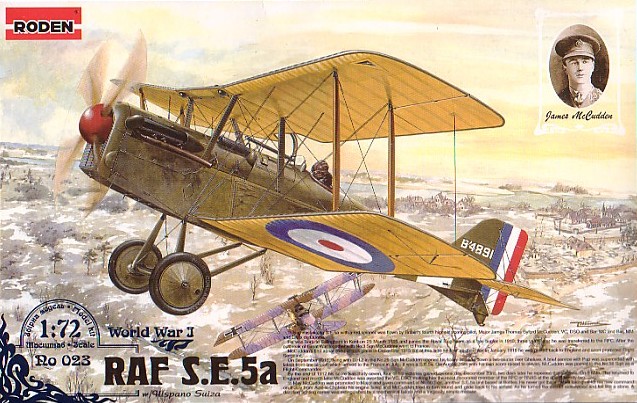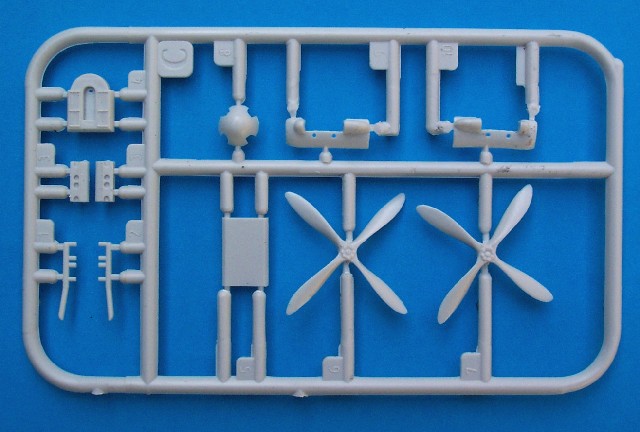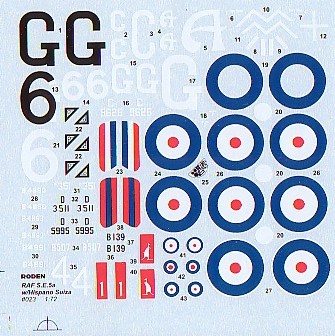|
RAF SE5a
with Hispano Suiza
Engine

Roden 1/72
S
u m m a r y
|
| Catalogue Number: |
RAF SE5a (w/Hispano Suiza) Roden kit
# 023 |
| Scale: |
1/72 |
| Contents and Media: |
See text below |
| Price: |
USD$8.97 from Squadron.com
|
| Review Type: |
FirstLook |
| Advantages: |
Good research, fine detail, delicate
wings, gloss decals. |
| Disadvantages: |
Fit of cockpit section tricky, no
rigging diagram. |
| Recommendation: |
Recommended |
Reviewed by Robert Baumgartner

Roden's 1/72 scale
SE5a w/Hispano Suiza is available online from Squadron.com
After the “Viper”, the logical progression for Roden was to release a
kit of the Hispano Suiza powered SE5a. The only changes needed to the kit
contents are the inclusion of sprue C. This contains the new engine cowls,
two types of 4 bladed propeller, radiator, and exhausts.

Click the thumbnails below
to view larger images:
Per the first release of the SE5a, the box contains three sprues in the
familiar light grey plastic. Also retained is the lovely acetate sheet
that provides the various windscreens and “window” for allowing light onto
the cockpit.
Comparison to photos and available plans show that Roden has done a good
job with the major outlines. All parts compare favourably to Ian Stair’s
plans in both the Albatros Productions Datafile on the SE5a and the SE5a
Special. Be careful when you overlay the parts because reproduction of the
plans in my two editions were not printed in the indicated scale.
The flying surfaces have not suffered at all during the production run and
retain the fine trailing edges that have become Roden's hallmark. As
expected, the ribs are beautifully restrained but there is a slight bump
that needs sanding off on the underside of the port upper wing.
The built in dihedral of the one-piece wings greatly eases the modeller’s
task although the lower wing on my example needed an upward tweaking to
match that of its mate.
Roden gives us a good head start with the cockpit by including the seat,
rudder bar, control column, instrument panel and shelf. There is some
structural detail found on the interior of the fuselage halves but
thankfully this doesn’t equate to sink marks on the opposite surface.
Instead we are greeted by superbly subtle detail that faithfully captures
the look of a fabric-covered airframe.
As mentioned earlier, sprue C is the latest addition and is moulded to the
same high standards as seen with the other parts. The LVG C.V spinner for
B’4891 is a bonus as is both types of four bladed prop.
Items that are familiar to us from the earlier release are the three
styles of top deck, a couple of types of two bladed propeller, and both
the steel and later wooden undercarriage legs. Ever welcome is the row of
4 x 25lb Cooper bombs.
The “jigsaw” assembly of the fuselage will test the modeller as Roden try
to get maximum use out of the existing moulds for each variant. The result
is the builder having to be patient and dry fit everything very carefully
before committing glue to plastic.
Modellers will be left to make their own control horns, as these are too
delicate on the SE5a for even Roden to mold onto the wings. Indentations
are present to show the correct placement.
Surprisingly no rigging diagram is provided so maximum use must be made of
the box top.
Don’t be confused if the construction side of the instruction sheet is
vague as to which exhausts, prop, undercarriage, windscreen etc. is
applicable to each version. All this is made clear under the heading of
the individual machine in the painting guide. This is to stop the
instruction sheet from being too cluttered.
As usual, Roden are very generous with the number of options they
provide for the builder. In this case we are treated to nine aircraft.
A close look at the decal sheets reveals a welcome departure from the
usual matt carrier film. This time it is gloss! In previous cases, the
matt decals were prone to silvering and brittleness. The testing of a
couple of the rudder flashes showed that my examples did not shatter and
settled down well to the gloss surface on which they were applied.
Generally registration was good but a couple of the smaller roundels did
suffer slightly. Also supplied as decals, are the inspection windows and
pulleys located on the wings.
 I)
SE5a D3511 (Vickers built) flown by Major R S Dallas of 40 Sqn. RFC, May
1918. I)
SE5a D3511 (Vickers built) flown by Major R S Dallas of 40 Sqn. RFC, May
1918.
On 8 May 1918, D3511 was used to shoot down an Albatros D.V., which
became the first of five enemy aircraft in this machine. After his death
on another aircraft, D3511 was used to good effect by Gwilym Lewis who
managed to down a Fokker D.VII and LVG within a week of each other.
II) SE5a B139 (Martinsyde-built)
No.111 Sqn. RFC, Palestine, January 1918
Photographs of this aircraft do in fact show that Roden are correct in
depicting it with rack full of 25-lb Cooper bombs. At one stage of its
life, B139 had what is believed to be an extra oil-cooling device mounted
below the engine. This would have to be scratch built.
III) SE5a D’351/ “4” (Vickers
built), No.6 (Training) Sqn., AFC, Minchinhampton, late 1918
IV) SE5a D5995/ “1” (Vickers
built) flown by Lt. L Lucas of No.143 (HD) Sqn. RFC London Air Defence,
April/May 1918.
V) SE5a B507/ “A” (Vickers built)
flown by 2/Lt. J J Fitzgerald of 60 Sqn., RFC, France, November 1917.
Fitzgerald had engine failure in this machine on 5 October 197 which
forced him to land in enemy territory where the machine was captured
intact by the Germans.
VI) SE5a B4890/ “C” (RAF built)
flown by 2/Lt. A Dodds of 56 Sqn. RFC, France, November 1917.
This machine was forced down on November 29 and Dodds was made a POW.
His victor was Ltn. Schubert of Jasta 6 and the cameras were there at the
Jasta 5 airfield in Boistrancourt to record images of his aircraft.
VII) SE5a C9626 (Vickers built)
flown by Capt. S P Simpson of 32 Sqn., RFC, France, May 1918
VIII) SE5a B4863/ “G” (RAF built)
flown by Capt. J T B McCudden of 56 Sqn., RFC, France, September 1917.
This is an obvious but welcome choice from Roden. Nine victories were
scored in B4863 between the 19th September and the 21st of October. The
aircraft was eventually wrecked when it ran into a house while landing at
night at 53 Sqn.
IX) SE5a B’4891/ “6” (RAF built)
flown by Capt. J T B McCudden of 56 Sqn., RFC, France, February 1918.
McCudden scored his first victory piloting an SE5a with this aircraft.
He flew it from December 1917 until March 1918, before he left 56 Sqn. The
white patches under the lower wing “6” are leftover markings of the letter
‘G’. This letter was used as a Flight marking early in McCudden's use of
B’4891. When the “G” was changed to a six, the spinner of an LVG was
added, this being from an aircraft he had shot down the previous November.
He shot down more aircraft (32) in B’ 4891 than in any other machine he
flew. After McCudden left, this aircraft had 2 more successes, this time
in the hands of Major C M Crowe.
Roden’s family of SE5a fighters eclipses all others. With the care that
has been taken with research, each kit promises to be winner. The sheer
number of optional parts means that there is no excuse for the modeler not
being able to accurately build the aircraft of their choosing. Just be
careful of the fit.
Roden are to be applauded for listening to the critics of their matt
decals. The change to the gloss format can only enhance an already fine
product.
Recommended
Thanks to
Squadron.com for the review
sample.
Review and Images Copyright © 2003 by
Robert Baumgartner
Page Created 12 February, 2003
Last updated 09 November, 2003
Back to HyperScale Main Page
Back to Reviews Page
|
Home | What's
New | Features
| Gallery |
Reviews | Reference
| Forum
| Search